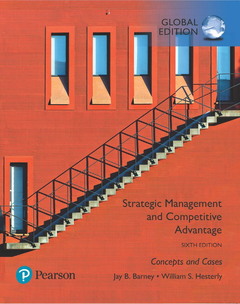Description
Strategic Management and Competitive Advantage: Concepts and Cases, Global Edition (6th Ed.)
Authors: Barney Jay, Hesterly William
Language: English
Subject for Strategic Management and Competitive Advantage: Concepts...:
544 p. · 20.3x25.1 cm · Paperback
Description
/li>Contents
/li>Biography
/li>Comment
/li>
For courses in strategy and strategic management.
Strategic Management and Competitive Advantage: Concepts and Cases strips out the unnecessary, by presenting material that answers the question: does this concept help students analyse real business situations? Each chapter has four short sections that cover specific issues in depth, allowing professors to adapt the text to their particular needs. By utilising this carefully crafted approach, the 6th Edition provides students with the tools they need for strategic analysis.
PART I: THE TOOLS OF STRATEGIC ANALYSIS
1. What is Strategy and the Strategic Management Process?
2. Evaluating a Firm’s External Environment
3. Evaluating a Firm’s Internal Capabilities
END-OF-PART I: CASES PC 1—1
PART II: BUSINESS-LEVEL STRATEGIES
4. Cost Leadership
5. Product Differentiation
6. Flexibility and Real Options
7. Collusion
END-OF-PART II: CASES PC 2—1
PART III: CORPORATE STRATEGIES
8. Vertical Integration
9. Corporate Diversification
10. Organizing to Implement Corporate Diversification
11. Strategic Alliances
12. Mergers and Acquisitions
END-OF-PART III: PC 3—1
Appendix: Analyzing Cases and Preparing for Class Discussions
Glossary
Company Index
Name Index
Subject Index
Jay Barney is currently a Presidential Professor of Strategic Management and holds the Lassonde Chair in Social Entrepreneurship at the Eccles School of Business at the University of Utah. He received his undergraduate degree from Brigham Young University, and his master’s and PhD degrees from Yale University. Previously, he served on the faculties at the Anderson Graduate School of Management at UCLA, the Mays School of Business at Texas A&M University, and as the Chase Chair for Excellence in Strategic Management at the Fisher College of Business at the Ohio State University. He has also served as a visiting scholar at INSEAD in Fontainebleau, France and as a visiting professor at the Said Business School at Oxford University, United Kingdom.
Most of Professor Barney’s research focuses on how firms can gain and sustain competitive advantages. He has published over 100 articles in a variety of outlets, including the Harvard Business Review, the Sloan Management Review, the Strategic Management Journal, the Academy of Management Review , the Academy of Management Journal, and has published six books, including a novel titled What I Didn’t Learn at Business School: How Strategy Works in the Real World (with Trish Gorman). He has published some of the most widely cited papers in the field of strategic management.
Professor Barney has won several awards for his research and writing, including the Irwin Outstanding Educator Award for the Business Policy and Strategy Division of the Academy of Management, the Scholarly Contributions Award for the Academy of Management, and three honorary doctoral degrees -- from Lund University (Sweden), the Copenhagen Business School (Denmark), and Universidad Pontifica Comillas (Spain). He has also been elected to the Academy of Management Fellows and the Strategic Management Society Fellows and has won teaching awards at UCLA, Texas A&M, and Ohio Sta
Help students develop critical-thinking skills
· New - Chapter Six summarizes the latest theoretical and empirical work on the value of strategic flexibility. It describes the settings under which flexibility will create value, and how that value can be estimated.
· New - Chapter Seven explores the economic -- and ethical -- implications of explicit and tacit collusion. Even if a particular firm chooses to not engage in collusion, it must still understand this strategy and its economic consequences, because some of its competitors may choose this strategy.
· The fundamental concepts include a five forces framework, value chain analysis, generic strategies, and corporate strategy. VRIO framework is used through the text to help students understand Strategic Management concepts.
Engaging examples from recent strategic management models
· New and Updated - Opening Cases in the text and instructor’s manual use timely examples on:
o New - “Go, Pokémon, Go” in Chapter One: This case discusses how the Pokemon altered reality game was created, and asks if this product will be a source of sustained competitive advantage.
o New - “How Attractive is the Music Streaming Business?” in Chapter Two: Music streaming services are very popular, but very few make money. Why is this the case, and what impact will this have on the strategies of these firms.
o New - “When a Noun Becomes a Verb” in Chapter Three: Why has Google gained a competitive advantage, and will the company be able to sustain it?
Present specific issues and research made relevant in a flexible format
Each chapter presents specific issues in more depth, allowing professors and students to adapt the text to their particular needs:
· Strate




